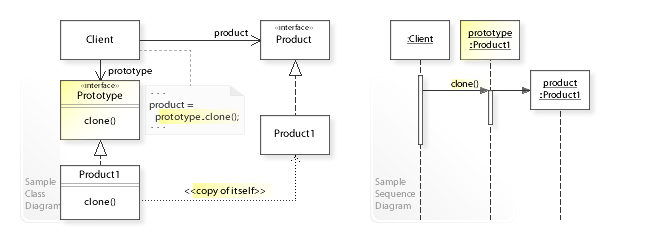importstd;usingstd::array;usingstd::shared_ptr;usingstd::unique_ptr;usingstd::vector;enumclassDirection:char{NORTH,SOUTH,EAST,WEST};classMapSite{public:virtualvoidenter()=0;virtualunique_ptr<MapSite>clone()const=0;virtual~MapSite()=default;};classRoom:publicMapSite{private:introomNumber;shared_ptr<array<shared_ptr<MapSite>,4>>sides;public:explicitRoom(intn=0):roomNumber{n},sides{std::make_shared<array<shared_ptr<MapSite>,4>>()}{}~Room()=default;Room&setSide(Directiond,shared_ptr<MapSite>ms){(*sides)[static_cast<size_t>(d)]=std::move(ms);std::println("Room::setSide {} ms",d);return*this;}virtualvoidenter()override{}virtualunique_ptr<MapSite>clone()constoverride{returnstd::make_unique<Room>(*this);}Room(constRoom&)=delete;Room&operator=(constRoom&)=delete;};classWall:publicMapSite{public:Wall():MapSite(){}~Wall()=default;virtualvoidenter()override{}[[nodiscard]]virtualunique_ptr<MapSite>clone()constoverride{returnstd::make_unique<Wall>(*this);}};classDoor:publicMapSite{private:shared_ptr<Room>room1;shared_ptr<Room>room2;public:explicitDoor(shared_ptr<Room>r1=nullptr,shared_ptr<Room>r2=nullptr):MapSite(),room1{std::move(r1)},room2{std::move(r2)}{}~Door()=default;virtualvoidenter()override{}[[nodiscard]]virtualunique_ptr<MapSite>clone()constoverride{returnstd::make_unique<Door>(*this);}voidinitialize(shared_ptr<Room>r1,shared_ptr<Room>r2){room1=std::move(r1);room2=std::move(r2);}Door(constDoor&)=delete;Door&operator=(constDoor&)=delete;};classMaze{private:vector<shared_ptr<Room>>rooms;public:Maze()=default;~Maze()=default;Maze&addRoom(shared_ptr<Room>r){std::println("Maze::addRoom {}",reinterpret_cast<void*>(r.get()));rooms.push_back(std::move(r));return*this;}[[nodiscard]]shared_ptr<Room>roomNo(intn)const{for(constRoom&r:rooms){// actual lookup logic here... }returnnullptr;}[[nodiscard]]virtualunique_ptr<Maze>clone()const{returnstd::make_unique<Maze>(*this);}};classMazeFactory{public:MazeFactory()=default;virtual~MazeFactory()=default;[[nodiscard]]virtualunique_ptr<Maze>makeMaze()const{returnstd::make_unique<Maze>();}[[nodiscard]]virtualshared_ptr<Wall>makeWall()const{returnstd::make_shared<Wall>();}[[nodiscard]]virtualshared_ptr<Room>makeRoom(intn)const{returnstd::make_shared<Room>(n);}[[nodiscard]]virtualshared_ptr<Door>makeDoor(shared_ptr<Room>r1,shared_ptr<Room>r2)const{returnstd::make_shared<Door>(std::move(r1),std::move(r2));}};classMazePrototypeFactory:publicMazeFactory{private:unique_ptr<Maze>prototypeMaze;shared_ptr<Room>prototypeRoom;shared_ptr<Wall>prototypeWall;shared_ptr<Door>prototypeDoor;public:MazePrototypeFactory(unique_ptr<Maze>m,shared_ptr<Wall>w,shared_ptr<Room>r,shared_ptr<Door>d):MazeFactory(),prototypeMaze{std::move(m)},prototypeRoom{std::move(r)},prototypeWall{std::move(w)},prototypeDoor{std::move(d)}{}~MazePrototypeFactory()=default;virtualunique_ptr<Maze>makeMaze()constoverride{returnprototypeMaze->clone();}[[nodiscard]]virtualshared_ptr<Room>makeRoom(intn)constoverride{returnprototypeRoom->clone();}[[nodiscard]]virtualshared_ptr<Wall>makeWall()constoverride{returnprototypeWall->clone();}[[nodiscard]]virtualshared_ptr<Door>makeDoor(shared_ptr<Room>r1,shared_ptr<Room>r2)constoverride{shared_ptr<Door>door=prototypeDoor->clone();door->initialize(std::move(r1),std::move(r2));returndoor;}MazePrototypeFactory(constMazePrototypeFactory&)=delete;MazePrototypeFactory&operator=(constMazePrototypeFactory&)=delete;};classMazeGame{public:MazeGame()=default;~MazeGame()=default;[[nodiscard]]unique_ptr<Maze>createMaze(MazePrototypeFactory&factory){unique_ptr<Maze>maze=factory.makeMaze();shared_ptr<Room>r1=factory.makeRoom(1);shared_ptr<Room>r2=factory.makeRoom(2);shared_ptr<Door>door=factory.makeDoor(r1,r2);maze->addRoom(std::move(r1)).addRoom(std::move(r2));r1->setSide(Direction::NORTH,factory.makeWall()).setSide(Direction::EAST,door).setSide(Direction::SOUTH,factory.makeWall()).setSide(Direction::WEST,factory.makeWall());r2->setSide(Direction::NORTH,factory.makeWall()).setSide(Direction::EAST,factory.makeWall()).setSide(Direction::SOUTH,factory.makeWall()).setSide(Direction::WEST,door);returnmaze;}};intmain(intargc,char*argv[]){MazeGamegame;MazePrototypeFactorysimpleMazeFactory(std::make_unique<Maze>(),std::make_shared<Wall>(),std::make_shared<Room>(0),std::make_shared<Door>());unique_ptr<Maze>maze=game.createMaze(simpleMazeFactory);}Maze::addRoom0x1160f50Maze::addRoom0x1160f70Room::setSide00x11613c0Room::setSide20x1160f90Room::setSide10x11613e0Room::setSide30x1161400Room::setSide00x1161420Room::setSide20x1161440Room::setSide10x1161460Room::setSide30x1160f90

